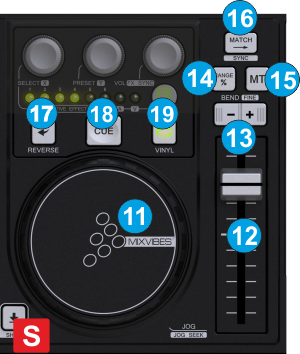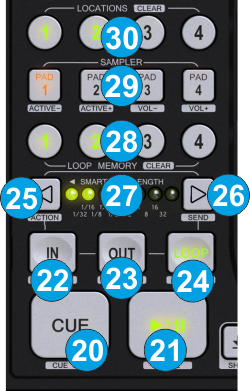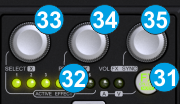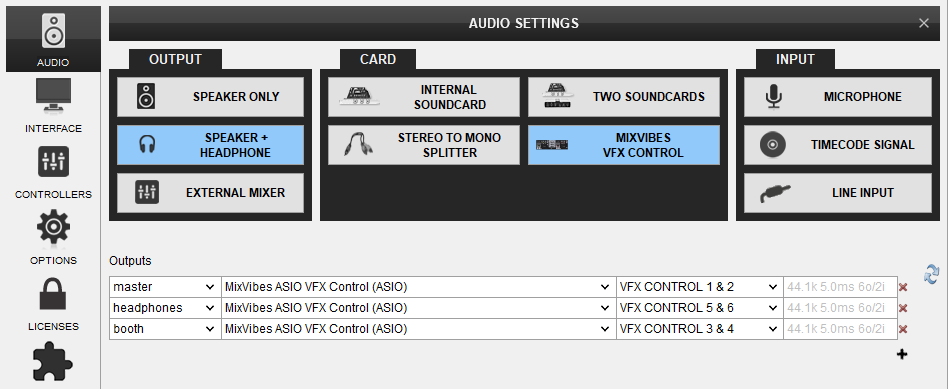MIXVIBES - VFX Control

SETUP
Drivers
Drivers (for Windows only): Install the latest ASIO drivers from the CD that came with your controller or download from http://forum.mixvibes.com/downloads.php?cat=83 (you will need to create a Profile and register the serial number of the bundled software you will find at the Installation CD )
No drivers is required for Mac OSX computers.
Connections
- Connect the unit with a USB port of your computer, using the provided USB cable
- Connect a pair of amplified speakers or an amplifier to the PLAYER 1 Output at the rear panel of the unit, using proper RCA cables
- Connect a pair of Headphones (for pre-listening) to the rear PHONES socket, using a proper 1/4" adapter.
- Connect the supplied AC/DC Adapter to the rear DC-IN socket.
- Plug the AC/DC Adapter to an AC power outlet
- Press the top-left power button at the top panel of the unit
VirtualDJ Setup
Once VirtualDJ 8 is launched, a Login Window will appear to enter your virtualdj.com account credentials.
A Pro Infinity, a Plus or a Pro Subscription License is required to fully use the Mixvibes VFX Control. Without any of the above Licenses, the controller will operate for 10 minutes each time you restart VirtualDJ.
http://www.virtualdj.com/buy/index.html

Click on the "Use Soundcard" button if your speakers are connected to the Player 1 Output of the VFX Control
Click to OK

The unit is now ready to operate.
MIDI Operation
The unit should be visible in the CONTROLLERS tab of Config and the “factory default” available/selected from the Mappings drop-down list. The factory default Mapping offers the functions described in this Manual, however those can be adjusted to your needs via VDJ Script actions.

Find more details at http://www.virtualdj.com/wiki/VDJ8script.html
AUDIO Setup
The unit has a pre-defined Audio setup and a special button in the AUDIO tab of Config to provide that. Alternative Audio setups can be applied in the same window.

Alternative audio configurations can be applied. See Advanced Audio Setup
For further software settings please refer to the User Guides of VirtualDJ 8.
http://www.virtualdj.com/manuals/virtualdj8/index.html
LAYOUT

The functionality of each button, knob and connection per section (as shown in the image above) will be explained in detail in the following chapters
S SHIFT Hold this button down to access secondary functions of VFX Control (mainly in black lettering inside a gray box)
A Mixer & Browser Controls
B Jog & Tempo Controls
C Deck Controls
D Effects
E Rear panel
MIXER & BROWSER CONTROLS

- CROSSFADER. Blends audio between the left and right assigned decks.
- VOLUME. Use the Volume faders to adjust the Output Volume of left/right Decks.
- EQ LOW. Adjust the Low frequencies of the Left/Right Deck
- EQ MID. Adjust the Middle frequencies of the Left/Right Deck
- EQ HIGH. Adjust the High frequencies of the Left/Right Deck
- LOAD LEFT. Loads the selected track from the Browser to the Left Deck. Hold the same button for more than 1 second to unload the deck.
Hold SHIFT down and then use this button to get the Browser Zoom view (with mini decks and much larger Browser height). This feature is available in the Default VirtualDJ skins and several custom ones. - LOAD RIGHT. Loads the selected track from the Browser to the Right Deck. Hold the same button for more than 1 second to unload the deck.
Hold SHIFT down and then use this button to cycle through the 4 center mixer panels of the default VirtualDJ skins (Mixer, Video, Scratch and Master). - MEDIA SELECT. Turn this encoder clockwise/anti-clockwise to browse through folders or tracks depending on the selected Browser window. Push to toggle selection between the Folders and the Songs Browser windows. When in Folders, push and hold for more than 1 seconds to open/close sub-folders.
Hold SHIFT down and then turn this encoder to cycle the Sideview Browser window through the available views (Automix, Sidelist, Sampler, Karaoke and Shortcuts). Hold SHIFT and then push this encoder to set focus to the Sideview Browser window. Hold SHIFT and then push and hold the encoder for more than 1 second to open/close the Sideview.

- CUE VOL. Adjust the output volume of the Headphones Channel. (software knob - can be assigned to any VDJ script action)
- GAIN. Use these knobs to adjust the pre-fader output of Left/Right Decks. (software knobs - can be assigned to any VDJ script action)
Jog & Tempo Controls

- JOG. Touch sensitive jogwheel. When in Vinyl/ mode, use the upper part to pause and scratch the track and the outer part to bend. When Vinyl mode is disabled, use any part of the jogwheel to bend (temporary speedup/slow-down speed).
Hold SHIFT down and then use the jogwheel to fast seek through the track. - PITCH. Use this fader to adjust the tempo of the track. In the middle position, the track will be played at its original tempo (BPM). Move towards up to slow down and towards down to speed up.
- PITCH BEND. Use these buttons to temporary (while pressed) speedup/slow-down the tempo of the track. When released, the track will continue playback at the tempo designated by the Pitch fader.
- RANGE. Use this button to select the next available -%/+% range for the Pitch fader.
Hold SHIFT down and then use this button to enable/disable Pitch-Lock. When enabled (LED will blink), adjusting the Tempo of a track using the Pitch fader, will also adjust the tempo of the other track by the same amount. - MT. Use this button to enable/disable Master Tempo (Key-Lock). When enabled, the Key of the track will retain ts value when the Pitch fader alters its tempo.
- MATCH. Use this button match BPM and phase of the track with the ones from the opposite deck. Hold SHIFT down and then use this button to reset the track's tempo to its original value. The LED of this button will blink while the pitch is resetting to 0.
- REVERSE. Play the track with reversed direction while the button is pressed. When the button is released, the track will resume playing forward from the position it would have been if the button was never pressed.
Hold SHIFT down to toggle the playing direction of the track. - CUE. Use this button to send the deck's audio signal to the Headphones channel (for pre-listening).
- VINYL. Use this button to enable/disable Vinyl mode for the jogwheel. Hold SHIFT down and then use this button to enable/disable Slip mode. When Slip mode is enabled, several actions like Hotcues, scratching and Loops will act temporary (while performed) and when these actions are disabled/released the track will continue playing from the position it would have been if these actions were never performed.
DECK CONTROLS

- PLAY: Play/Pauses the track. Hold SHIFT and then press this button to apply a Brake effect on pause or play
- CUE: When the Deck is paused, you can set a temporary Cue Point by moving the Platter to place the Audio Pointer at the desired location and then pressing the Cue Button. During playback, you can press the Cue Button to return the track to this Cue Point. (If you did not set a Cue Point, then it will return to the beginning of the track.). If the Deck is paused, you can press and hold the Cue Button to play the track from the Temporary Cue Point. Releasing the Cue Button will return the track to the temporary Cue Point and pause it. To continue playback without returning to the Temporary Cue Point, press and hold the Cue Button, then press and hold the Play Button, and then release both buttons.
Hold SHIFT and then press this button to return to the beginning of the track - LOOP IN. When track is not in Loop, use this button to set current track's position as the start point of a manual loop. When in Loop, use this button to set the Jogwheel to Loop In Adjust mode (LED will blink) and then use the jogwheel to fine-adjust this position.
Hold SHIFT down and then use this button to move the Loop backwards in time by 1 beat. - LOOP OUT. When track is not in Loop, use this button to set current track's position as the end point of a manual loop and enable the Loop. When in Loop, use this button to set the Jogwheel to Loop Out Adjust mode (LED will blink) and then use the jogwheel to fine-adjust this position.
Hold SHIFT down and then use this button to move the Loop forward in time by 1 beat. - LOOP. When track is not in Loop, use this button to enable an Auto-Loop of the selected size in beats When in Loop, use this button to exit the Loop.
Hold SHIFT down and then use this button to enable/disable Smart Loop. When enabled, manual loops created with the In/Out Loop buttons will snap to the nearest size in beats, creating a seamless loop. - LOOP HALF. Use this button to half the size of the Loop in beats.
Hold SHIFT down and then use this button to cycle through the 3 available view modes for the Loop Led Bar (Loop size, VU meter and Song Progress) - LOOP DOUBLE. Use this button to double the size of the Loop in beats.
Hold SHIFT down and then use this button to enable/disable Loop Roll mode. When enabled, after a Loop is disabled, the track will continue playback from the position it would have been if the Loop was never triggered. - LOOP LED BAR. The 7 Leds of the Loop Bar offer 3 different views (selected by SHIFT+LOOP HALF) . In Loop size mode (default) the Leds of the Loop Bar will designate the size of the Loop, as per the silkscreen of the unit. In VU meter mode, the Leds designate the output pre-fader volume of each deck. In Song Progress mode, the Leds designate the part of the track that has been played already and will blink when track reaches 30 seconds before its end.
- LOOP MEMORY BUTTONS 1-4. Use these buttons to save, recall and delete up to 4 Saved Loops.Press a button to save the current loop to slots 1 to 4. Press the same button to recall (enable the Loop but not jump to its position if later to the current one. Hold the same button for more than 1 second to delete the Loop from the slot.
Hold SHIFT down and then use these buttons to enable the saved Loop but also jump to its position. - SAMPLER BUTTONS 1-4. Use these buttons to trigger Samples 1 to 8 from the selected Sampler Bank. If the selected Sampler Bank has less than 5 samples, both sides of the unit will trigger the same samples 1 to 4. If the selected Sampler Bank has more than 4 samples, the left side Sampler buttons will trigger Samples 1 to 4 and the right-side Sampler buttons will trigger Samples 5 to 8. The Sampler Bank selection is done from the VirtualDJ GUI (Sampler view of Sideview)
Hold SHIFT down and then use these buttons to stop the playing Sample. Useful when the Un-mute or Stutter Sampler trigger mode is selected. - LOCATION BUTTONS. Use these buttons to save, recall and delete Hotcues 1 to 4. When a Hotcue is not assigned, use a button to save current track's position to Hotcue 1 to 4. Use the same button to recall and jump the track to that position. Hold SHIFT down and then use the same button to delete its assigned Hotcue.
EFFECT CONTROLS
 The Effects section of the VFX CONTROL offers 3 different modes. Single Audio FX, Multi Audio FX and Video FX modes. These modes are selected via the FX/MODE button.
The Effects section of the VFX CONTROL offers 3 different modes. Single Audio FX, Multi Audio FX and Video FX modes. These modes are selected via the FX/MODE button.- FX/MODE:Use this button to toggle between the Audio and Video mode for the FX section.
When in Audio FX mode, hold SHIFT down and then use this button to toggle between Single and Multi Audio FX modes. - FX LED BAR:The 8 sequential Leds will indicate the status of the Audio or Video Effects, depending on the selected mode, as explained further in this chapter.
Audio Single FX mode
- FX ENC 1: Turn this encoder to select an Audio Effect.
Push the encoder to enable/disable the selected Effect to Left/Right Deck. Hold SHIFT and then push the encoder to open/close the Effect's GUI at the side of the Browser and view all of its Parameters.
The 1st LED from left will blink if the Effect is enabled and solid if not. - FX ENC 2: Turn this encoder to adjust the 1st Parameter of the selected Effect. Hold SHIFT down and then use the same encoder to adjust its 3rd Parameter.
Push the encoder to enable/disable the 1st Parameter button of the selected Effect. Hold SHIFT and then push the encoder to enable/disable the 3rd Parameter button of the selected Effect (if available)
The 2nd LED from left will be turned off in this mode - FX ENC 3: Turn this encoder to adjust the 2ndParameter of the selected Effect. Hold SHIFT down and then use the same encoder to adjust its 4thParameter.
Push the encoder to enable/disable the 2ndParameter button of the selected Effect. Hold SHIFT and then push the encoder to enable/disable the 4th Parameter button of the selected Effect (if available)
The 3rd LED from left will be turned off in this mode
Audio Multi FX mode
- FX ENC 1: Turn this encoder to adjust the 1st Parameter of the selected Effect of the FX Slot 1. Hold SHIFT down and then use this encoder to adjust the 2nd Parameter of the selected Effect in FX Slot 1
Push the encoder to enable/disable the selected Effect in FX Slot 1.. Hold SHIFT down and then push the encoder to select the next available Effect for FX Slot 1
The 1st LED from left will blink if the Effect in FX Slot 1 is enabled and solid if not. - FX ENC 2: Turn this encoder to adjust the 1st Parameter of the selected Effect of the FX Slot 2. Hold SHIFT down and then use this encoder to adjust the 2nd Parameter of the selected Effect in FX Slot 2
Push the encoder to enable/disable the selected Effect in FX Slot 2.. Hold SHIFT down and then push the encoder to select the next available Effect for FX Slot 2
The 2nd LED from left will blink if the Effect in FX Slot 2 is enabled and solid if not. - FX ENC 3: Turn this encoder to adjust the 1st Parameter of the selected Effect of the FX Slot 3. Hold SHIFT down and then use this encoder to adjust the 2nd Parameter of the selected Effect in FX Slot 3
Push the encoder to enable/disable the selected Effect in FX Slot 3.. Hold SHIFT down and then push the encoder to select the next available Effect for FX Slot 3
The 3rd LED from left will blink if the Effect in FX Slot 3 is enabled and solid if not.
Video FX mode
- FX ENC 1: Turn this encoder to apply a High/Low-Pass Filter to the left/right deck. Push to reset and turn off Filter.
The 4th LED from left, will blink if Filter is applied and solid if not. - FX ENC 2: Turn this encoder to adjust the Key of the track. Push this encoder to reset the Key of the track to its original value. Hold SHIFT and then push the encoder to match the key of the deck with the opposite deck's value.
The 5th LED from left will blink if the current Key of the deck is different than its original. - FX ENC 3 LEFT: Turn the left-side encoder to select a Video Transition. Push the left-side encoder to manually trigger the selected video transition.
Hold SHIFT and then use the left-side encoder to adjust the 1st Parameter of the selected Video Transition (if available). Hold SHIFT down and then push the left-side encoder to open/close its GUI at the side of the Browser and see all of its available Parameters (if any)
The 6th left-side LED from left will blink if a Video Transition is performed
FX ENC 3 RIGHT: Turn the right-side encoder to select a Video Effect for the Master Video Output. Push the right-side encoder to manually trigger the selected Video Effect.
Hold SHIFT and then use the right-side encoder to adjust the 1st Parameter of the selected Video Effect (if available). Hold SHIFT down and then push the right-side encoder to open/close its GUI at the side of the Browser and see all of its available Parameters (if any)
The 6th right-side LED from left will blink if a Video Effect is enabled
REAR PANEL

- USB. This USB connection sends and receives audio and control information from a connected computer.
- PLAYER 1 OUT: Use standard RCA cables to connect this output to a speaker or amplifier system. Alternatively this output can be used to route Left Deck's audio signal to an external audio mixer. See Advanced Audio Setup
- PHONES . Connect your headphones to this output for cueing and mix monitoring using a 1/4" cable/adapter. This output can be also used for other purposes. See Advanced Audio Setup
- POWER: Use the included power adapter (12 V DC,, center-positive) to connect VFX Control to a power outlet. While the power is switched off, plug the cable into the unit first, and then plug the other end into a power outlet. Use the Power Switch at the top panel to turn the unit on and off. Turn on the unit after all input devices have been connected and before you turn on amplifiers. Turn off amplifiers before you turn off the unit
- PLAYER 2 OUT: This output can be used for either connecting to a booth monitor speaker or route Right Deck's audio signal to an external audio mixer. See Advanced Audio Setup
ADVANCED SETUP
The VFX Control offers a built-in USB Audio interface with 3 stereo outputs that can be used in various ways and setups.
MASTER & HEADPHONES SETUP
By default, the unit is pre-defined to operate as a all-in-one controller and the audio mixing to be performed by the internal VirtualDJ mixer. In this case, the PLAYER 1 Audio Output (Channels 1,2) is used to connect to an amplified system and the PHONES 1/4" Output (Channels 5,6) to connect your Headphones for pre-listening. The pre-defined Audio setup is offered with the special button at the top of the AUDIO tab of VirtualDJ Settings as per the image below.

EXTERNAL MIXER SETUP
The unit offers the necessary outputs to connect an external audio mixer and route the left and right VirtualDJ decks to separate audio channels. In this case, the PLAYER 1 Audio Output (Channels 1,2) can output the audio signal of the Left VirtualDJ deck and the PLAYER 2 Audio Output (Channels 3,4) can output the audio signal of the Right VirtualDJ Deck, if the audio setup of the image below is applied in Audio setup of VirtualDJ. Press the EXTERNAL MIXER button at the top to get this setup

Keep in mind that the mixer section of the VFX Control will still alter Volume, Equalizer and Gain to the Left/Right decks, so in case of an external mixer, you may need to disable this functionality. In order to do that, you will just need to edit the default action of the ONINIT key in the Mapping and set the vfx_extmixer variable to 1 as per the image below. Set it back to 0 if you need the mixer of the VXF Control to control the internal mixer of VirtualDJ.

3RD OUTPUT - ALTERNATIVE SETUPS
The remaining Output (3,4 or 5,6 depending on the previously selected Audio setup) can be used for additional outputs, such as dedicated Sampler Output or Booth Output. There is also no restriction to what Channels (connections) you will use for Decks, Master, Headphones or other outputs.
In the following example, PLAYER 1 (Channels 1,2) is used as Master Output, PHONES (channels 5,6) is used for Headphones pre-listening output and PLAYER 2 (Channels 3,4) is used to connect a Booth monitor speaker.

